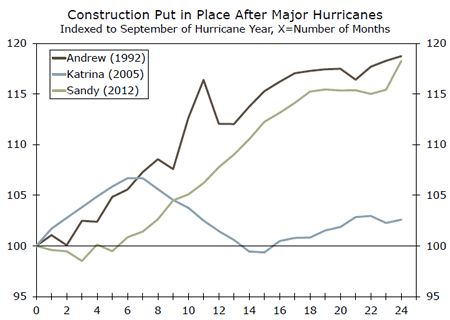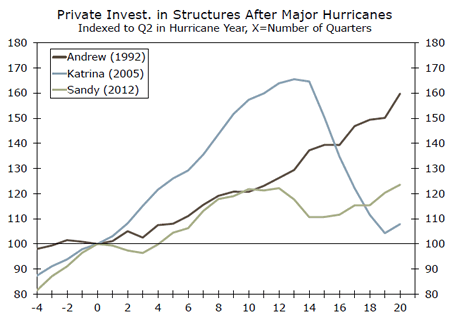U.S. Review
Harvey and Irma Push Up Inflation and Retail Sales
- Higher gasoline prices and replacing storm-damaged property put upward pressure on the CPI and retail sales in September. Core CPI came in softer than expected, which does little to clarify the underlying inflation trend the Fed is seeking.
- Small business owners were hit by the storms as well, but small business optimism remains strong despite contending with increasing difficulty finding qualified workers. JOLTS data in August confirmed that demand for labor is strong and September’s slip in payrolls is likely to reverse easily.
Hurricanes Cloud Data Takeaways
Interpreting the hurricane-impacted string of data releases over the next few months is nuanced but not impossible. Most of the economy was on solid footing before the storms and large swings in the data are very likely to prove transitory. The large drop in payrolls in September will likely reverse in October, as we know the labor market is strong and demand will warrant the creation of more jobs. One area that is less obvious is the inflation data. Continued misses in gauges of price changes for much of this year has been vexing, especially because underlying fundamentals should support greater inflation pressure than has actually played out. Hurricane Harvey’s aim at the Gulf Coast certainly pushed up prices, though we know the effect is transitory. The problem for the FOMC is trying to flush out the underlying inflation pressure from the transitory effects. As inflation did not show much sign of acceleration before the storms, basing decisions on incoming inflation data in the months ahead is quite tricky.
August JOLTS data show demand for labor was solid before the storms, suggesting the decline in September should reverse rather easily. Openings remained at their record highs, though that did little to entice workers to leave their current positions. The quit rate held in its 2.1-2.2 percent range that it has bounced between each month this year, leaving 2.2 percent as cycle high.
Many small businesses are finding it difficult to find qualified workers, according to the September NFIB survey also released this week. Among respondents attempting to hire, 86 percent said there were few or no qualified applicants. The problem is most acute for manufacturers and construction firms. Overall small business optimism slipped in September, partially reflecting the impact from the storms. Optimism still remains near cycle high.
Producer prices in September pointed to firming inflation. Energy prices contributed to a sizable 0.4 percent rise in producer prices on the month. The volatile trade component helped push services prices up 0.4 percent, and higher energy costs also helped boost prices for transportation on the month. Though construction costs were little changed in September, they will likely continue on the recent upward trend as rebuilding from the hurricanes get underway. Although not the Fed’s primary inflation gauge, the PPI has firmed over the year and is behaving in a way supportive of the Fed’s inflation objectives. Headline PPI is up 2.6 percent while core PPI, which excludes food and energy, is up 2.2 percent.
The storms pushed up consumer prices, particularly at the gas pump, as expected. Headline CPI rose 0.5 percent on the month, though core inflation rose 0.1 percent, which was below the consensus of 0.2 percent. The softer showing in the core did little to give the Fed clarity on the underlying inflation trend.
Retail sales received a large boost from storm-related purchases. Replacing cars and paying more at the pump pushed retail sales up 1.6 percent on the month. Control group sales were up a solid 0.4 percent which suggests the strong showing in September was not only because of hurricanes, as it excludes autos and gas as well as food services and building materials.
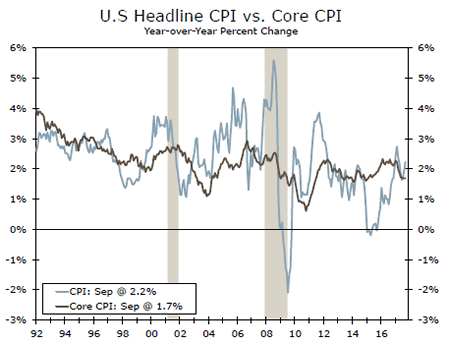
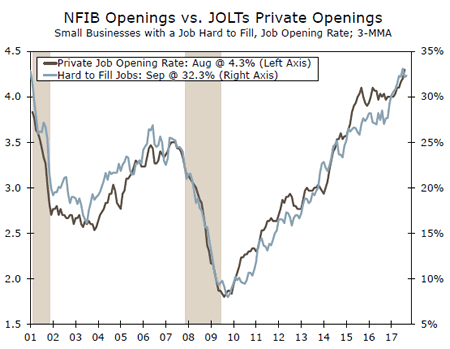
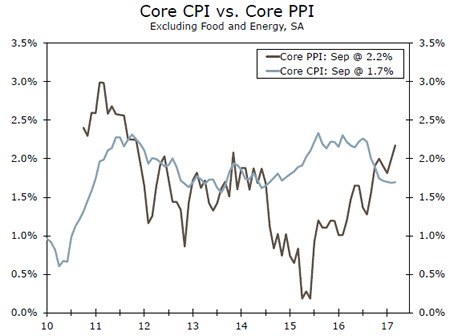
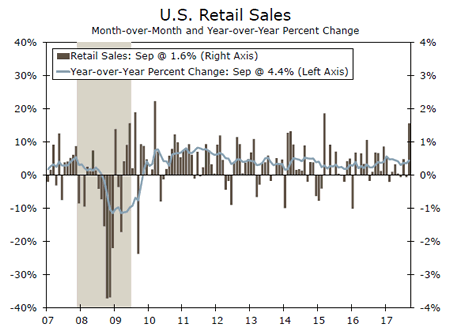
U.S. Outlook
Industrial Production • Tuesday
Output at the nation’s factories, mines and utilities fell 0.9 percent in August after Hurricane Harvey hit the Gulf Coast. The storm was estimated to have reduced the monthly change in industrial production by about three-quarters of a percentage point. In the manufacturing sector, a rise in durables output was not enough to offset outages at refineries, chemical plants and plastics factories. At the same time, mild weather weighed heavily on utilities output.
With Irma making landfall two weeks later, we expect to see another drop in September. Power outages in Florida will have weighed on utilities output, while the ISM supplier delivery index suggests production disruptions continued last month. We look for industrial production to have declined 0.6 percent in September but expect a substantial rebound in October.
Previous: -0.9% Wells Fargo: -0.6% Consensus: 0.3% (Month-over-Month)
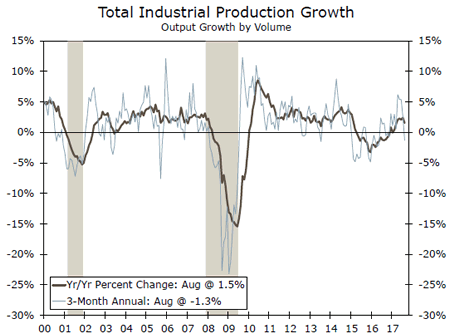
Housing Starts • Wednesday
Housing starts edged down in August amid further weakness in the multi-family segment. Single family starts, however, continued their upward trend and are up nearly 9 percent year-to-date.
We expect starts to have fallen slightly to a 1.17 million annualized pace in September after hurricanes Harvey and Irma hit Texas and Florida, two of the largest and fastest-growing housing markets this year. Low mortgage rates and strong permitting activity— particularly in the multifamily segment, where permits were up 20 percent last month—suggest that the damage will be relatively contained in September. That said, overall new construction is likely to remain weak between now and the end of the year, as repair efforts divert labor and materials and delay new construction.
Previous: 1.18 Million Wells Fargo: 1.17 Million Consensus: 1.18 Million
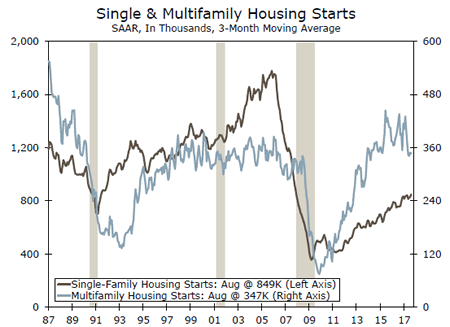
Leading Economic Index • Thursday
The Leading Economic Index is expected to show another gain in September, suggesting the economy will continue to expand in the coming months. The pace, however, looks likely to slow a bit due to disruptions stemming from the recent storms.
Leading indicators of the labor market, including jobless claims and the average workweek deteriorated last month and are expected to pull the index lower. Higher stock prices in September, however, as well as relatively easy credit conditions implied by the Leading Credit Index and interest rate spread, should be enough to offset the dip. Along with a boost from the ISM manufacturing report’s new orders index, we look for the LEI to have risen 0.2 percent last month.
Previous: 0.4% Wells Fargo: 0.2% Consensus: 0.1% (Month-over-Month)
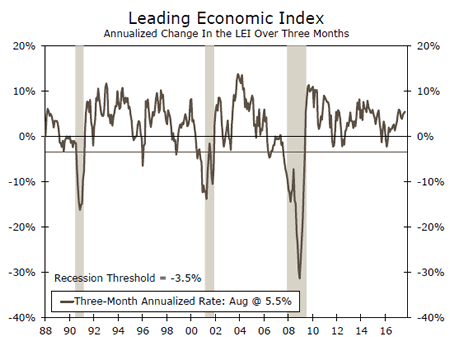
Global Review
Global Growth Appears to Have Been Solid in Q3
- Real GDP growth in Singapore, an important bellwether for global economic growth, strengthened to a three-year high in the third quarter. It appears that the British economy continued to expand at a modest pace in Q3, and real GDP growth in the Eurozone remained solid.
- On balance, global economic growth appears to have strengthened recently. However, the modest downshift in economic momentum that appears to be underway in China is a reminder that the global economy is not exactly "booming" yet either.
Global Growth Appears to Have Been Solid in Q3
As usual, Singapore this week was the first country to release GDP data from the just-completed quarter. As shown on the graph on the front page, the year-over-year rate of real GDP growth in the Lion City picked up from 2.9 percent in Q2-2017 to 4.6 percent in the third quarter, the strongest year-over-year rate of growth in more than three years. The preliminary supply-side disaggregation that was released showed that the pick-up in the overall rate of real GDP growth was driven largely by acceleration in the manufacturing sector. A breakdown of the quarterly GDP data into its underlying demand-side components is not yet available, but the strength in the manufacturing sector is consistent with monthly data indicating that export growth was solid in the third quarter. The small economy of Singapore is not that important in terms of global economy growth. However, the extensive trade ties that Singapore has with many other economies make it an important bellwether for the state of global economic growth.
The United Kingdom has not yet released GDP data for third quarter, but a widely respected think tank in that country estimates that real GDP grew 0.4 percent (not annualized) in the July-to-September period relative to the second quarter (top chart). The think tank’s estimate, which has had a good track record over the years, is in line with our own estimate of Q3 GDP growth. In general, the British economy has decelerated somewhat this year, but growth remains positive. Data released this week showed that British industrial production (IP) grew for the fifth consecutive month in August, giving credence to estimates that U.K. real GDP growth remained positive in the third quarter.
Speaking of the industrial sector, IP in the Eurozone rose 1.4 percent in August relative to the previous month. Data released earlier had shown that German IP jumped 2.6 percent during the month, but the outturn for the overall euro area was still much stronger than most analysts had expected. As shown in the middle chart, there is a clear upturn in Eurozone IP growth that is underway this year. As we have written previously, we expect the economic expansion in the Eurozone to remain intact for the foreseeable future and we look for the ECB to take further steps in coming months to dial back its degree of monetary policy accommodation.
In contrast to the modest acceleration we are seeing in some other major economies, recent economic data out of China suggest that economic growth in the world’s second-largest economy may have downshifted a tad in Q3. Export growth in China has softened a bit in recent months as did import growth (bottom chart). The latter would be consistent with some deceleration in domestic demand in China. On balance, it appears that global economic growth has strengthened recently. However, the modest downshift in economic momentum that appears to be underway in China is a reminder that the global economy is not exactly "booming" yet either.
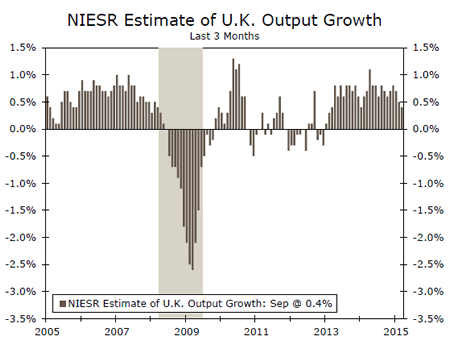
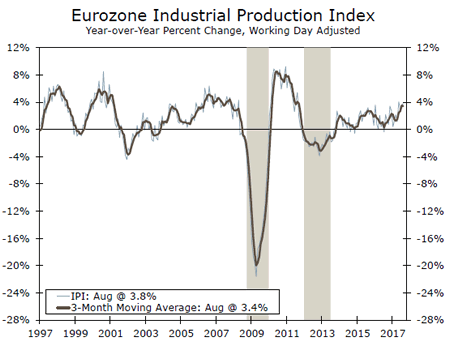
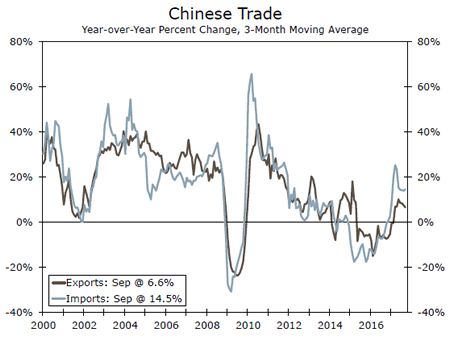
Global Outlook
Germany ZEW • Tuesday
The German and Eurozone economies have been steadily, and slowly, improving. Consequently, there is renewed speculation that the ECB is considering the need to start taking measures to unwind the monetary expansion implemented over the past several years.
On Tuesday markets are expected to get information on the ZEW current situation and expectations indices for both Germany and the Eurozone for the month of October. These indices have been, in general, on an upward trajectory during the past several years with the current situation index hitting 87.9 in September in Germany and 31.7 in the Eurozone.
Meanwhile, the expectation index has been very volatile, both in Germany and in the Eurozone but improved in September. A further improvement in these indices would cement the view that the region is continuing to improve.
Previous: 87.9 Consensus: 88.5
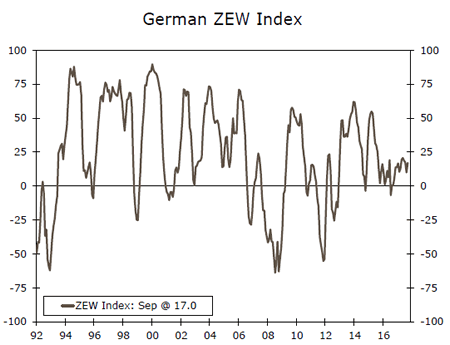
China Q3 GDP • Wednesday
Our forecast for the Chinese economy calls for a further slowdown in the coming years. However, the result for the second quarter was a bit stronger than what markets had expected, up 6.9 percent on a year-earlier basis.
On Wednesday, the markets will have an opportunity to gauge the staying power of the Chinese economy again, especially if they can keep the growth rate steady at the 6.9 percent rate they recorded during the second quarter.
Although we have seen some improvement in the Chinese PMI manufacturing index, the improvement has not mimicked the strong improvement we have seen in the United States and in the Eurozone and thus we are still calling for Chinese economic growth to slowly weaken. We expect a rate of growth of 6.7 percent during the third quarter of the year.
Previous: 6.9% Wells Fargo: 6.7% Consensus: 6.8% (Year-over-Year)
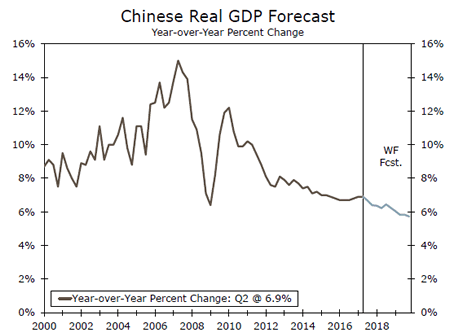
Brazil Economic Activity • Wednesday
The Brazilian economy has been slowly coming out of its worst recession in history lately. However, the monthly economic activity numbers, which are a proxy for the behavior of GDP, have not been consistent with a sustained recovery, up one month, down the next.
On Wednesday the Brazilian economic activity index for August will hit the wire and it will be nice to see some stability from this index. The July year-over-year number was 1.4 percent while the monthover- month print was also positive, up 0.4 percent. That is, a repeat of July’s performance with both the year-over-year as well as the monthly number would help cement expectations of a sustained recovery for the Brazilian economy. Still, we are not expecting the economy to recover at a fast pace even after two years of dismal economic activity. The political crisis in the country is still lingering and a full recovery will take a relatively long time.
Previous: 0.4% Consensus: -0.3% (Month-over-Month)
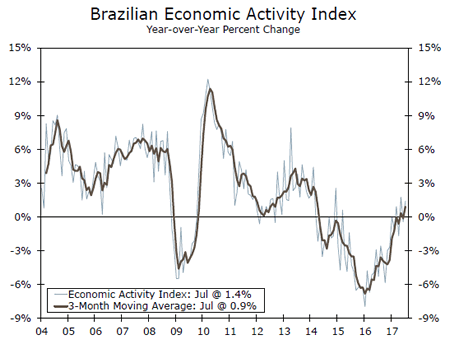
Point of View
Interest Rate Watch
A Cautious Climb.
Our outlook for interest rates projects a cautious climb in rates as the Fed adjusts policy towards a perceived normalization of both the funds rate and the Fed’s balance sheet. However, normalization from a stance of administered, below market equilibrium interest rates will be anything but normal. As interest rates are a price for credit, the challenge in the markets will be a movement from policy set to market determined interest rates. We are cautious on the transition.
Steady Domestic Demand—at Low Rates
As illustrated by the top graph, domestic real final sales, at the current FOMC determined low interest rates has been very steady in recent years. Consumer spending has been solid and housing starts have improved over recent years. However, we are aware that light vehicles sales as well as housing will be sensitive to a rising interest rate path.
Crossing the Streams: From Negative to Positive Real Rates
Over the next two years, short-term interest rates should cross into positive territory (middle graph) and will be there for the first time for a sustained basis since 2007. There are two issues. First, decisions made at negative real rates that now must be refinanced at positive rates will be challenged. Second, as the FOMC pursues its intended policy, investors will quickly judge that the total return of some past investments made at lower rates will quickly negative total returns.
Our Outlook: Rising Rates with Caution
Over the next two years we do see that interest rates will rise modestly. However, over the past four years we have been below consensus on the extent of any interest rate rise and we were right. For 2017, for example, we anticipated that the 10-year rate would be up 2.5 percent, below the 2.7 percent Blue Chip Consensus.
If interest rates were to rise as much as the FOMC intends, we believe economic growth would be damped and possibly lead to a recession on the basis of our published work. Therefore, the FOMC will likely limit its rate increases.
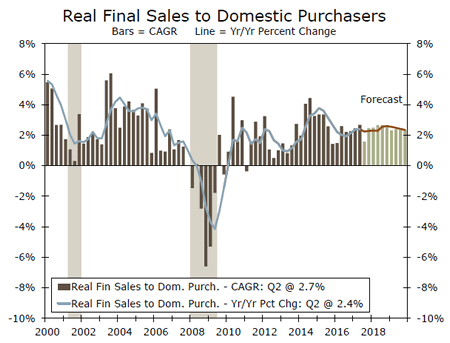
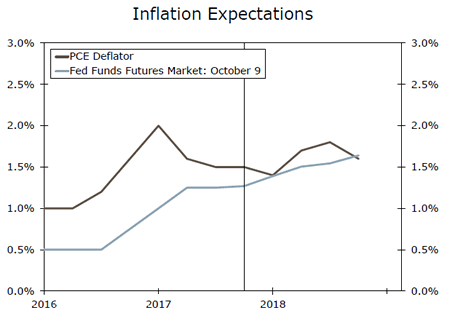
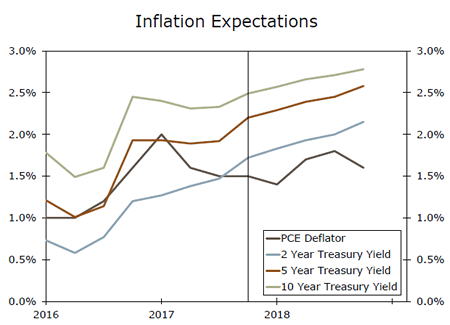
Credit Market Insights
Consumer Credit Slows in August
Consumer credit rose $13.3 billion, representing a modest pullback from July. Consumer credit is up just 4.2 percent year over year, down from a 5.7 percent rise in the prior month. Revolving credit remains just below its pre-recession peak, climbing 7.0 percent year over year in August, while non-revolving credit, up just 3.2 percent year over year, currently sits at a record high. The limited rise in personal consumption for August likely translated into the slowdown of consumer borrowing for the month. Our expectation is for consumer credit to gradually grow.
Although consumer credit slowed in August, it remained elevated as a percentage of disposable income. At 26.1 percent, consumer credit currently represents its largest share of disposable income since the start of the series in 1960. Commercial banks continue to hold the largest share of consumer credit, followed closely by the federal government. Financial companies and credit unions largely round out the remaining portion of the consumer credit pie.
The federal government holds
approximately 40 percent of all nonrevolving credit, which includes student loans and mortgages, up from holding just 15 percent in 2010. We expect the growth of this share to persist as educational costs continue to rise.
Consumer credit is expected to expand as strong consumer confidence remains at elevated levels.
Topic of the Week
Past Storms Offer Little Clues for CRE Spending
Every hurricane affects the national construction numbers differently. Major storms affected two large commercial real estate markets this year, Harvey in Texas and Irma in Florida. Estimates already put the storms among the most costly on record.
Reviewing past data on value of construction put in place following Andrew in 1992, Katrina in 2005 and Sandy in 2012 bears little fruit. Construction values stumbled slightly in the months following Andrew but returned to trend rather quickly. It took slightly longer after Sandy and values rose uninterrupted after Katrina. That does not mean it will this time, however.
Andrew was an incredibly powerful and destructive storm, but damage was limited to South Florida. Katrina was certainly catastrophic, but it bore down on the Gulf Coast as its economy was already shrinking, and the rest of the country was enjoying a real estate boom. Sandy was likely the most relatable to Irma and Harvey, as it hit a very active real estate market in New York City and it affected a large chunk of the eastern seaboard. Still, rebuilding after Sandy took place later than expected which makes comparing that weather event with this one iffy at best.
Fixed investment in structures from the GDP tables also behaved differently in quarters following the past major storms, offering us little clues for coming months. The fact that Harvey affected some energy infrastructure puts its impact on fixed structure investment closer in line with Katrina’s aftermath. However, fixed structures investment continued uninterrupted in 2005.
There was a ramp up in construction costs about six months after Hurricane Andrew in 1992. Similarly sized bumps followed Katrina in 2005 and Sandy in 2012, but those occurred about a year later. Regardless, the recent storms are highly likely to cause a run up in costs in coming months. Construction labor is already in short supply, which has led to higher construction costs even before the hurricanes arrived.
